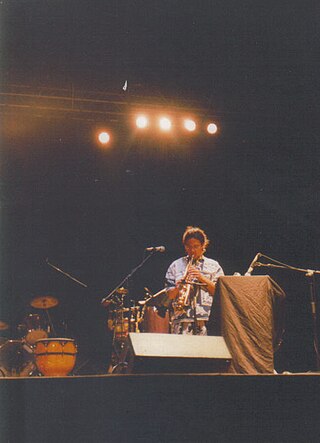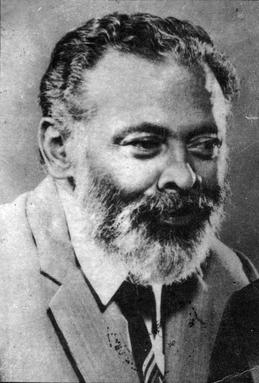
The highly diverse and distinctive music of Madagascar has been shaped by the musical traditions of Southeast Asia, Africa, Oceania, Arabia, England, France and the United States over time as indigenous people, immigrants, and colonists have made the island their home. Traditional instruments reflect these widespread origins: the mandoliny and kabosy owe their existence to the introduction of the guitar by early Arab or European seafarers, the ubiquitous djembe originated in mainland Africa and the valiha—the bamboo tube zither considered the national instrument of Madagascar—directly evolved from an earlier form of zither carried with the first Austronesian settlers on their outrigger canoes.

Jean-Joseph Rabearivelo, born Joseph-Casimir Rabearivelo, was a Malagasy poet who is widely considered to be Africa's first modern poet and the greatest literary artist of Madagascar. Part of the first generation raised under French colonization, Rabearivelo grew up impoverished and failed to complete secondary education. His passion for French literature and traditional Malagasy poetry (hainteny) prompted him to read extensively and educate himself on a variety of subjects, including the French language and its poetic and prose traditions. He published his first poems as an adolescent in local literary reviews, soon obtaining employment at a publishing house where he worked as a proofreader and editor of its literary journals. He published numerous poetry anthologies in French and Malagasy as well as literary critiques, an opera, and two novels.
African literature is literature from Africa, either oral ("orature") or written in African and Afro-Asiatic languages. Examples of pre-colonial African literature can be traced back to at least the fourth century AD. The best-known is the Kebra Negast, or "Book of Kings."

Jean-Luc Raharimanana is a Malagasy novelist, essayist, poet, and playwright.

Sorabe or Sora-be is an alphabet based on Arabic, formerly used to transcribe the Malagasy language and the Antemoro Malagasy dialect, dating from the 15th century.
Articles related to Madagascar include:
Hainteny is a traditional form of Malagasy oral literature and poetry, involving heavy use of metaphor. It is associated primarily with the Merina people of Madagascar. In its use of metaphor and allusion it resembles another type of poetry, the Malay pantun, and Fox suggests "it seems likely the Merina brought with them a Malayo-Polynesian poetic tradition" to Madagascar. The Ibonia, an epic poem related for centuries in different versions across Madagascar, reflects the value placed on the linguistic skills celebrated in the hainteny tradition, and offers insight into the diverse mythologies and beliefs of traditional Malagasy communities.
Malagasy mythology is rooted in oral history and has been transmitted by storytelling, notably the Andriambahoaka epic, including the Ibonia cycle. At least 52-59% of Madagascar are adherants of the religion, which is known as Fomba Gasy. Adherence to Fomba Gasy is high amongst the Sakalava people, as they are reluctant to convert to faiths of foreign origin.

The culture of Madagascar reflects the origins of the people Malagasy people in Southeast Asia, East Africa and Oceania. The influence of Arabs, Indians, British, French and Chinese settlers is also evident. The most emblematic instrument of Madagascar, the valiha, is a bamboo tube zither carried to the island by early settlers from southern Borneo, and is very similar in form to those found in Indonesia and the Philippines today. Traditional houses in Madagascar are likewise similar to those of southern Borneo in terms of symbolism and construction, featuring a rectangular layout with a peaked roof and central support pillar. Reflecting a widespread veneration of the ancestors, tombs are culturally significant in many regions and tend to be built of more durable material, typically stone, and display more elaborate decoration than the houses of the living. The production and weaving of silk can be traced back to the island's earliest settlers, and Madagascar's national dress, the woven lamba, has evolved into a varied and refined art. The Southeast Asian cultural influence is also evident in Malagasy cuisine, in which rice is consumed at every meal, typically accompanied by one of a variety of flavorful vegetable or meat dishes. African influence is reflected in the sacred importance of zebu cattle and their embodiment of their owner's wealth, traditions originating on the African mainland. Cattle rustling, originally a rite of passage for young men in the plains areas of Madagascar where the largest herds of cattle are kept, has become a dangerous and sometimes deadly criminal enterprise as herdsmen in the southwest attempt to defend their cattle with traditional spears against increasingly armed professional rustlers.

Andriana was both the noble class and a title of nobility in Madagascar. Historically, many Malagasy ethnic groups lived in highly stratified caste-based social orders in which the andriana were the highest strata. They were above the Hova and Andevo (slaves). The Andriana and the Hova were a part of Fotsy, while the Andevo were Mainty in local terminology.
Jacques Rabemananjara was a Malagasy politician, playwright and poet. He served as a government minister, rising to Vice President of Madagascar. Rabemananjara was said to be the most prolific writer of his negritude generation after Senghor, and he had the first négritude poetry published.

Malagasy is an Austronesian language and the national language of Madagascar. Malagasy is the westernmost Malayo-Polynesian language, brought to Madagascar by the settlement of Austronesian peoples from the Sunda islands around the 5th century AD. The Malagasy language is one of the Barito languages and is most closely related to the Ma'anyan language, still spoken on Borneo to this day. Malagasy also includes numerous Malay loanwords, from the time of the early Austronesian settlement and trading between Madagascar and the Sunda Islands. After c. 1000 AD, Malagasy incorporated numerous Bantu and Arabic loanwords, brought over by traders and new settlers.

Nicolas Vatomanga Andrianaivo Rakotovao, known as Nicolas Vatomanga is a Malagasy saxophonist, flutist, bandleader and composer. His music combines elements of jazz, blues and traditional musics of Madagascar, including: the hira gasy of the Centre, the beko from the South and the salegy from the North of the Great Island.

Elie Rajaonarison was a poet, artist, professor and civil servant from Madagascar. Considered the standard-bearer for modern Malagasy poetry, Rajaonarison's published poetry anthologies earned him international recognition and have been translated into French and English.

The Colony of Madagascar and Dependencies was a French colony off the coast of Southeast Africa between 1897 and 1958 in what is now Madagascar. The colony was formerly a protectorate of France known as Malagasy Protectorate. The protectorate became a colony, following Queen Ranavalona III's exile to Réunion.
The Democratic Movement for Malagasy Rejuvenation was the first political party formed in Madagascar, following the Brazzaville Conference of 1944 during which General Charles de Gaulle announced all colonies were to become French overseas territories entitled to representation in the French National Assembly.
Ny Avana Ramanantoanina (1891–1940) is among the most celebrated literary artists of Madagascar. He is principally renowned for his poetry, but also wrote stories and plays. He wrote during the colonial period and is considered to have been the first Malagasy writer to weave political messages into his work. He wrote primarily in the Malagasy language. A contemporary of Jean-Joseph Rabearivelo, who is commonly cited as the first African poet to write according to Western conventions, Ramanantoanina was highly critical of the French colonial authority. He was a member of the secret nationalist organization Vy Vato Sakelika, and was exiled to Mayotte in the Comoros when the organization was banned by the French colonial authority in 1917. His writings were consequently banned and were not reprinted until the 1980s in Madagascar. As a result, his writings are relatively less well known in international literary circles than those of Rabearivelo.

Jean Verdi Salomon Razakandraina (1913–1978), commonly known as Dox, was a Malagasy writer and poet considered one of the most important literary figures in the country's history. He is principally renowned for his poetry and plays, but was also a painter, wrote and performed musical compositions, and translated several major French and English language works into Malagasy. His works have formed part of the language arts curriculum in Madagascar at every grade level since the country regained independence in 1960.
Esther Razanadrasoa, pen name Anja-Z, (1892–1931) was a Malagasy poet and novelist who wrote in the Malagasy language. She was also the editor in chief of the literary journal Tsara Hafatra.